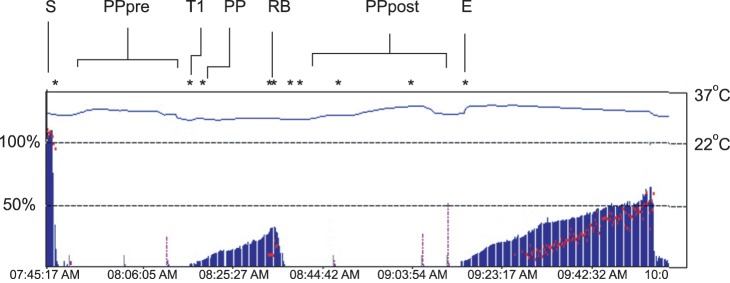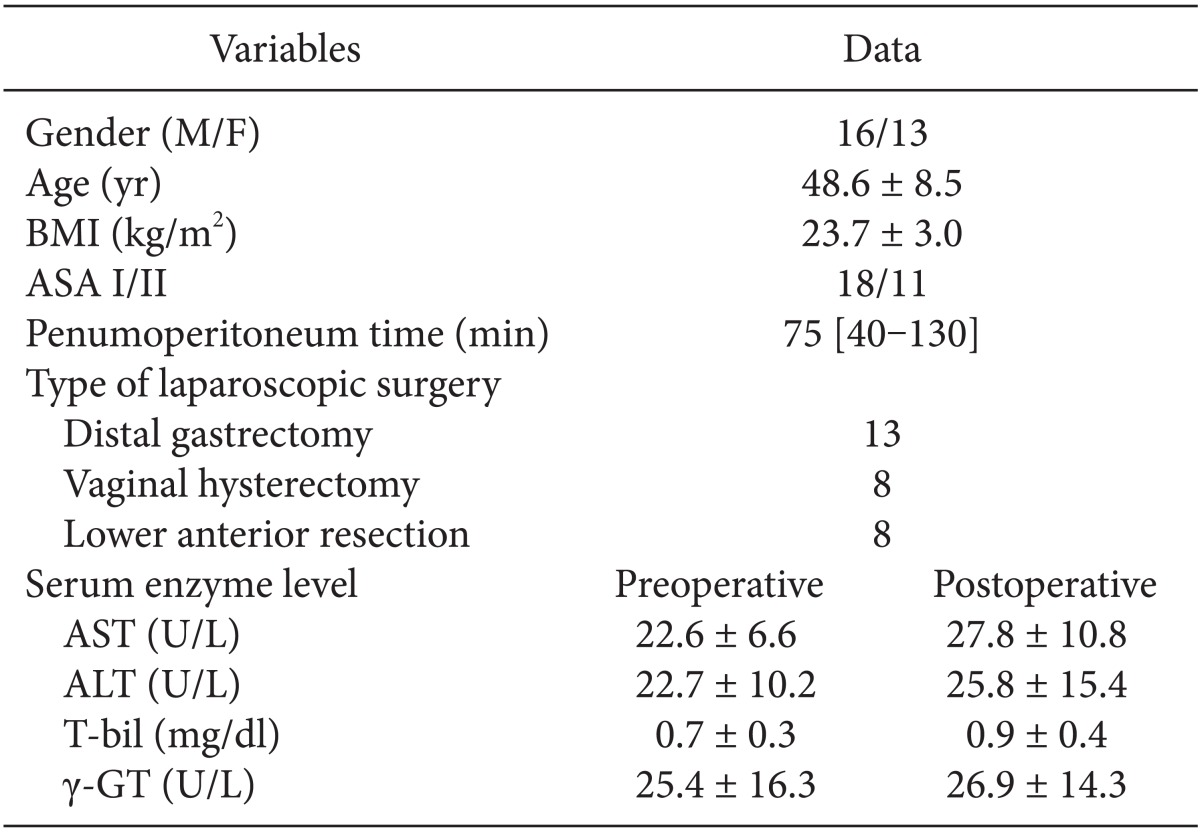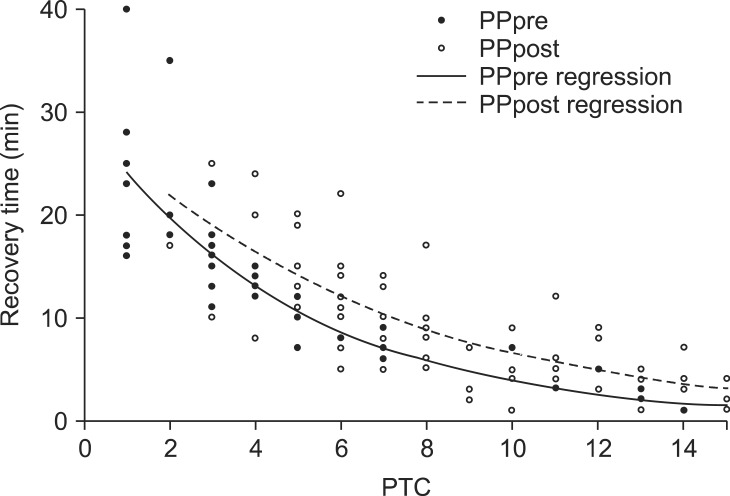1. Cuschieri A. Laparoscopic cholecystectomy. J R Coll Surg Edinb. 1999; 44:187–192. PMID:
10372492.
2. Koivusalo AM, Lindgren L. Effects of carbon dioxide pneumoperitoneum for laparoscopic cholecystectomy. Acta Anaesthesiol Scand. 2000; 44:834–841. PMID:
10939696.

3. Clarke RS, Doggart JR, Lavery T. Changes in liver function after different types of surgery. Br J Anaesth. 1976; 48:119–128. PMID:
3192.

4. Mogilner J, Sukhotnik I, Brod V, Hayari L, Coran AG, Shiloni E, et al. Effect of elevated intra-abdominal pressure in portal vein and superior mesenteric artery blood flow in a rat. J Laparoendosc Adv Surg Tech A. 2009; 19(Suppl 1):S59–S62. PMID:
19281420.
5. Omari A, Bani-Hani KE. Effect of carbon dioxide pneumoperitoneum on liver function following laparoscopic cholecystectomy. J Laparoendosc Adv Surg Tech A. 2007; 17:419–424. PMID:
17705719.

6. Staehr-Rye AK, Rasmussen LS, Rosenberg J, Juul P, Gätke MR. Optimized surgical space during low-pressure laparoscopy with deep neuromuscular blockade. Dan Med J. 2013; 60:A4579. PMID:
23461992.
7. Chiles KT, Feeney CM. Abdominal compartment syndrome successfully treated with neuromuscular blockade. Indian J Anaesth. 2011; 55:384–387. PMID:
22013257.

8. Viby-Mogensen J, Howardy-Hansen P, Chraemmer-Jørgensen B, Ording H, Engbaek J, Nielsen A. Posttetanic count (PTC): a new method of evaluating an intense nondepolarizing neuromuscular blockade. Anesthesiology. 1981; 55:458–461. PMID:
7294384.
9. Schultz P, Ibsen M, Østergaard D, Skovgaard LT. Onset and duration of action of rocuronium--from tracheal intubation, through intense block to complete recovery. Acta Anaesthesiol Scand. 2001; 45:612–617. PMID:
11309014.
10. Kim SY, Hwang KH, Han JW. Kim SY, editor. Clinical use of nondepolarizing neuromuscular relaxants; neuromuscular pharmacology in clinical anesthesia. 2nd ed. Seoul: Yomungak;2011. p. 149–154.
11. van Miert MM, Eastwood NB, Boyd AH, Parker CJ, Hunter JM. The pharmacokinetics and pharmacodynamics of rocuronium in patients with hepatic cirrhosis. Br J Clin Pharmacol. 1997; 44:139–144. PMID:
9278198.

12. Servin FS, Lavaut E, Kleef U, Desmonts JM. Repeated doses of rocuronium bromide administered to cirrhotic and control patients receiving isoflurane: A clinical and pharmacokinetic study. Anesthesiology. 1996; 84:1092–1100. PMID:
8624003.
13. Wang Z, Bao Y, Lu Z, Yu W. Is neuromuscular relaxation of rocuronium prolonged in patients with obstructive jaundice? Med Hypotheses. 2011; 76:100–101. PMID:
20832951.

14. Baykara N, Solak M, Toker K. Predicting recovery from deep neuromuscular block by rocuronium in the elderly. J Clin Anesth. 2003; 15:328–333. PMID:
14507556.

15. Khuenl-Brady K, Castagnoli KP, Canfell PC, Caldwell JE, Agoston S, Miller RD. The neuromuscular blocking effects and pharmacokinetics of ORG 9426 and ORG 9616 in the cat. Anesthesiology. 1990; 72:669–674. PMID:
1969717.

16. Magorian T, Wood P, Caldwell J, Fisher D, Segredo V, Szenohradszky J, et al. The pharmacokinetics and neuromuscular effects of rocuronium bromide in patients with liver disease. Anesth Analg. 1995; 80:754–759. PMID:
7893030.

17. Schachtrupp A, Toens Ch, Hoer J, Klosterhalfen B, Lawong AG, Schumpelick V. A 24-h pneumoperitoneum leads to multiple organ impairment in a porcine model. J Surg Res. 2002; 106:37–45. PMID:
12127806.

18. Hoekstra LT, Ruys AT, Milstein DM, van Samkar G, van Berge Henegouwen MI, Heger M, et al. Effects of prolonged pneumoperitoneum on hepatic perfusion during laparoscopy. Ann Surg. 2013; 257:302–307. PMID:
22824851.

19. Ueda N, Muteki T, Tsuda H. What anesthesiologist should know about neuromuscular monitoring today? J Anesth. 1992; 6:192–206. PMID:
15278565.

20. Kim HS, Lee KC, Lee DC, Jang J, Kim YB. Comparison of recovery times from deep neuromuscular blockade between single bolus and continuous infusion of rocuronium. Anesth Pain Med. 2009; 4:336–340.
21. Junghans T, Böhm B, Gründel K, Schwenk W, Müller JM. Does pneumoperitoneum with different gases, body positions, and intraperitoneal pressures influence renal and hepatic blood flow? Surgery. 1997; 121:206–211. PMID:
9037233.

22. Warlé MC, Berkers AW, Langenhuijsen JF, van der Jagt MF, Dooper PM, Kloke HJ, et al. Low-pressure pneumoperitoneum during plaparoscopic donor nephrectomy to optimize live doners' comfort. Clin Transplant. 2013; 27:E478–E483. PMID:
23795745.
23. Joshipura VP, Haribhakti SP, Patel NR, Naik RP, Soni HN, Patel B, et al. A prospective randomized, controlled study comparing low pressure versus high pressure pneumoperitoneum during laparoscopic cholecystectomy. Surg Laparosc Endosc Percutan Tech. 2009; 19:234–240. PMID:
19542853.

24. Suzuki T, Munakata K, Watanabe N, Katsumata N, Saeki S, Ogawa S. Augmentation of vecuronium-induced neuromuscular block during sevoflurane anaesthesia: comparison with balanced anaesthesia using propofol or midazolam. Br J Anaesth. 1999; 83:485–487. PMID:
10655928.

25. Bock M, Klippel K, Nitsche B, Bach A, Martin E, Motsch J. Rocuronium potency and recovery characteristics during steady-state desflurane, sevoflurane, isoflurane or propofol anaesthesia. Br J Anaesth. 2000; 84:43–47. PMID:
10740546.

26. Meretoja OA, Wirtavuori K, Taivainen T, Olkkola KT. Time course of potentiation of mivacurium by halothane and isoflurane in children. Br J Anaesth. 1996; 76:235–238. PMID:
8777103.

27. Jeong GA, Cho GS, Shin EJ, Lee MS, Kim HC, Song OP. Liver function alterations after laparoscopy-assisted gastrectomy for gastric cancer and its clinical significance. World J Gastroenterol. 2011; 17:372–378. PMID:
21253398.







 PDF
PDF Citation
Citation Print
Print


 XML Download
XML Download